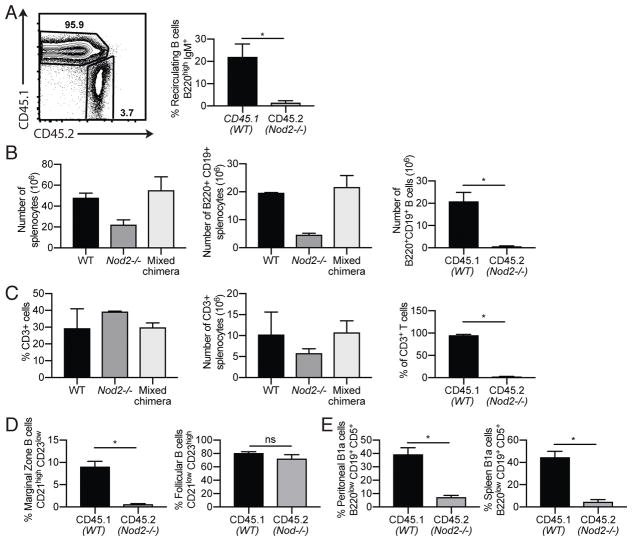Figure 2.
Proportions of Nod2−/− compared with wild-type B cells are decreased in mixed bone marrow chimera mice. Rag1−/− mice were reconstituted with mixed bone marrow from Nod2−/− (CD45.2+) and congenic CD45.1+ WT mice. (A) Representative plot of CD45.1+ and CD45.2+ mature B cells in the bone marrow. Single cells were gated on CD45.1 or CD45.2 followed by IgM versus B220. The percentages of CD45.1 or CD45.2 recirculating B cells are shown. (B) Number of total live cells and B220+ CD19+ B cells in the spleen. The percentages of B cells that are CD45.1 or CD45.2 are shown. (C) Percentage and numbers of CD3+ T cells in the spleen. The percentages of T cells that are CD45.1 or CD45.2 are shown. (D) Percentages of marginal zone (CD21 high CD23 low) and follicular (CD21 low CD23 high) B cells among CD45.1+ or CD45.2 positive cells in the spleen. (E) Percentages of B1a cells (B220 low, CD19+ CD5+) from peritoneal lavage and spleen. CD19+ CD3- cells were gated into CD45.1 and CD45.2 populations followed by B1 gate (CD19+ B220 low) from which B1a cells were gated (CD5+ B220 low). Data is representative of two independent experiments from a total of WT (n = 4), Nod2−/− (n = 8), and mixed bone marrow chimera Rag1−/− (n = 4) mice. ns p > 0.05 and *p ≤ 0.05 by two-tailed Mann-Whitney.

